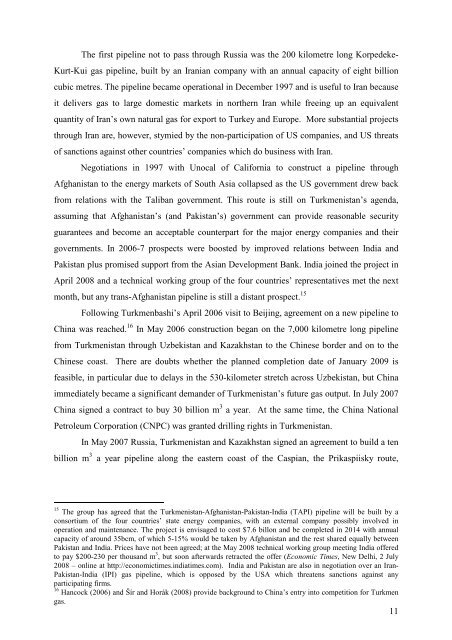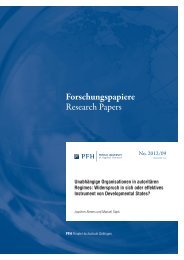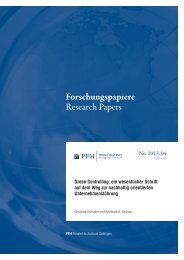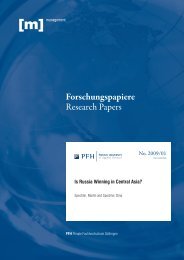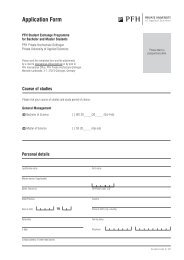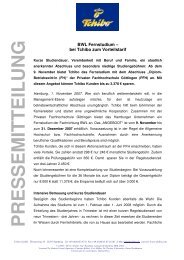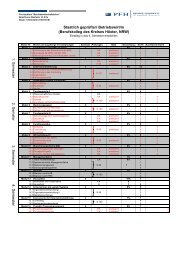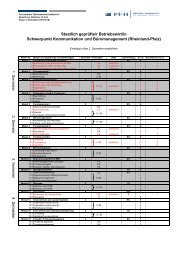Forschungspapiere Research Papers - PFH Private Hochschule ...
Forschungspapiere Research Papers - PFH Private Hochschule ...
Forschungspapiere Research Papers - PFH Private Hochschule ...
You also want an ePaper? Increase the reach of your titles
YUMPU automatically turns print PDFs into web optimized ePapers that Google loves.
The first pipeline not to pass through Russia was the 200 kilometre long Korpedeke-<br />
Kurt-Kui gas pipeline, built by an Iranian company with an annual capacity of eight billion<br />
cubic metres. The pipeline became operational in December 1997 and is useful to Iran because<br />
it delivers gas to large domestic markets in northern Iran while freeing up an equivalent<br />
quantity of Iran’s own natural gas for export to Turkey and Europe. More substantial projects<br />
through Iran are, however, stymied by the non-participation of US companies, and US threats<br />
of sanctions against other countries’ companies which do business with Iran.<br />
Negotiations in 1997 with Unocal of California to construct a pipeline through<br />
Afghanistan to the energy markets of South Asia collapsed as the US government drew back<br />
from relations with the Taliban government. This route is still on Turkmenistan’s agenda,<br />
assuming that Afghanistan’s (and Pakistan’s) government can provide reasonable security<br />
guarantees and become an acceptable counterpart for the major energy companies and their<br />
governments. In 2006-7 prospects were boosted by improved relations between India and<br />
Pakistan plus promised support from the Asian Development Bank. India joined the project in<br />
April 2008 and a technical working group of the four countries’ representatives met the next<br />
month, but any trans-Afghanistan pipeline is still a distant prospect. 15<br />
Following Turkmenbashi’s April 2006 visit to Beijing, agreement on a new pipeline to<br />
China was reached. 16 In May 2006 construction began on the 7,000 kilometre long pipeline<br />
from Turkmenistan through Uzbekistan and Kazakhstan to the Chinese border and on to the<br />
Chinese coast. There are doubts whether the planned completion date of January 2009 is<br />
feasible, in particular due to delays in the 530-kilometer stretch across Uzbekistan, but China<br />
immediately became a significant demander of Turkmenistan’s future gas output. In July 2007<br />
China signed a contract to buy 30 billion m 3 a year. At the same time, the China National<br />
Petroleum Corporation (CNPC) was granted drilling rights in Turkmenistan.<br />
In May 2007 Russia, Turkmenistan and Kazakhstan signed an agreement to build a ten<br />
billion m 3 a year pipeline along the eastern coast of the Caspian, the Prikaspiisky route,<br />
15 The group has agreed that the Turkmenistan-Afghanistan-Pakistan-India (TAPI) pipeline will be built by a<br />
consortium of the four countries’ state energy companies, with an external company possibly involved in<br />
operation and maintenance. The project is envisaged to cost $7.6 billon and be completed in 2014 with annual<br />
capacity of around 35bcm, of which 5-15% would be taken by Afghanistan and the rest shared equally between<br />
Pakistan and India. Prices have not been agreed; at the May 2008 technical working group meeting India offered<br />
to pay $200-230 per thousand m 3 , but soon afterwards retracted the offer (Economic Times, New Delhi, 2 July<br />
2008 – online at http://economictimes.indiatimes.com). India and Pakistan are also in negotiation over an Iran-<br />
Pakistan-India (IPI) gas pipeline, which is opposed by the USA which threatens sanctions against any<br />
participating firms.<br />
16 Hancock (2006) and Šír and Horák (2008) provide background to China’s entry into competition for Turkmen<br />
gas.<br />
11


